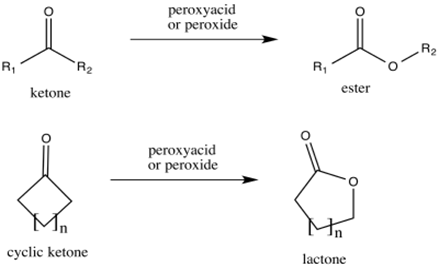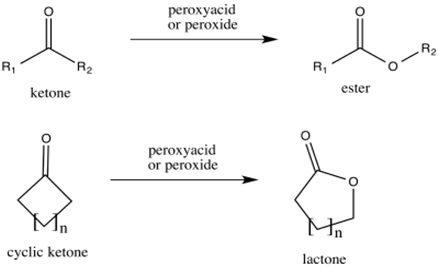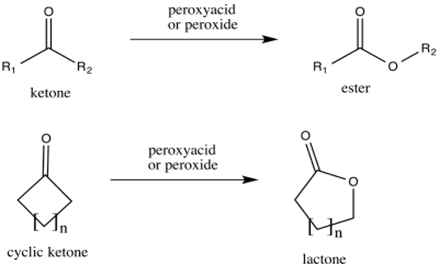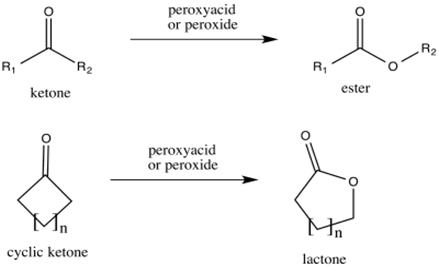
(a)
Interpretation:
The product obtained from the given reaction should be identified.
Concept introduction:
Reactions of
Aldehydes and ketones reacts with conjugate base of peroxides to form carboxylic acids and esters respectively.
This reaction is called as Baeyer-Villiger oxidation.

(b)
Interpretation:
The product obtained from the given reaction should be identified.
Concept introduction:
Reactions of aldehydes and ketones with peroxides:
Aldehydes and ketones reacts with conjugate bas of peroxides to form carboxylic acids and esters respectively.
This reaction is called as Baeyer-Villiger oxidation.

(c)
Interpretation:
The product obtained from the given reaction should be identified.
Concept introduction:
Reactions of aldehydes and ketones with peroxides:
Aldehydes and ketones reacts with conjugate bas of peroxides to form carboxylic acids and esters respectively.
This reaction is called as Baeyer-Villiger oxidation.

(d)
Interpretation:
The product obtained from the given reaction should be identified.
Concept introduction:
Reactions of aldehydes and ketones with peroxides:
Aldehydes and ketones reacts with conjugate bas of peroxides to form carboxylic acids and esters respectively.
This reaction is called as Baeyer-Villiger oxidation.

Want to see the full answer?
Check out a sample textbook solution
Chapter 17 Solutions
Organic Chemistry
 ChemistryChemistryISBN:9781305957404Author:Steven S. Zumdahl, Susan A. Zumdahl, Donald J. DeCostePublisher:Cengage Learning
ChemistryChemistryISBN:9781305957404Author:Steven S. Zumdahl, Susan A. Zumdahl, Donald J. DeCostePublisher:Cengage Learning ChemistryChemistryISBN:9781259911156Author:Raymond Chang Dr., Jason Overby ProfessorPublisher:McGraw-Hill Education
ChemistryChemistryISBN:9781259911156Author:Raymond Chang Dr., Jason Overby ProfessorPublisher:McGraw-Hill Education Principles of Instrumental AnalysisChemistryISBN:9781305577213Author:Douglas A. Skoog, F. James Holler, Stanley R. CrouchPublisher:Cengage Learning
Principles of Instrumental AnalysisChemistryISBN:9781305577213Author:Douglas A. Skoog, F. James Holler, Stanley R. CrouchPublisher:Cengage Learning Organic ChemistryChemistryISBN:9780078021558Author:Janice Gorzynski Smith Dr.Publisher:McGraw-Hill Education
Organic ChemistryChemistryISBN:9780078021558Author:Janice Gorzynski Smith Dr.Publisher:McGraw-Hill Education Chemistry: Principles and ReactionsChemistryISBN:9781305079373Author:William L. Masterton, Cecile N. HurleyPublisher:Cengage Learning
Chemistry: Principles and ReactionsChemistryISBN:9781305079373Author:William L. Masterton, Cecile N. HurleyPublisher:Cengage Learning Elementary Principles of Chemical Processes, Bind...ChemistryISBN:9781118431221Author:Richard M. Felder, Ronald W. Rousseau, Lisa G. BullardPublisher:WILEY
Elementary Principles of Chemical Processes, Bind...ChemistryISBN:9781118431221Author:Richard M. Felder, Ronald W. Rousseau, Lisa G. BullardPublisher:WILEY





